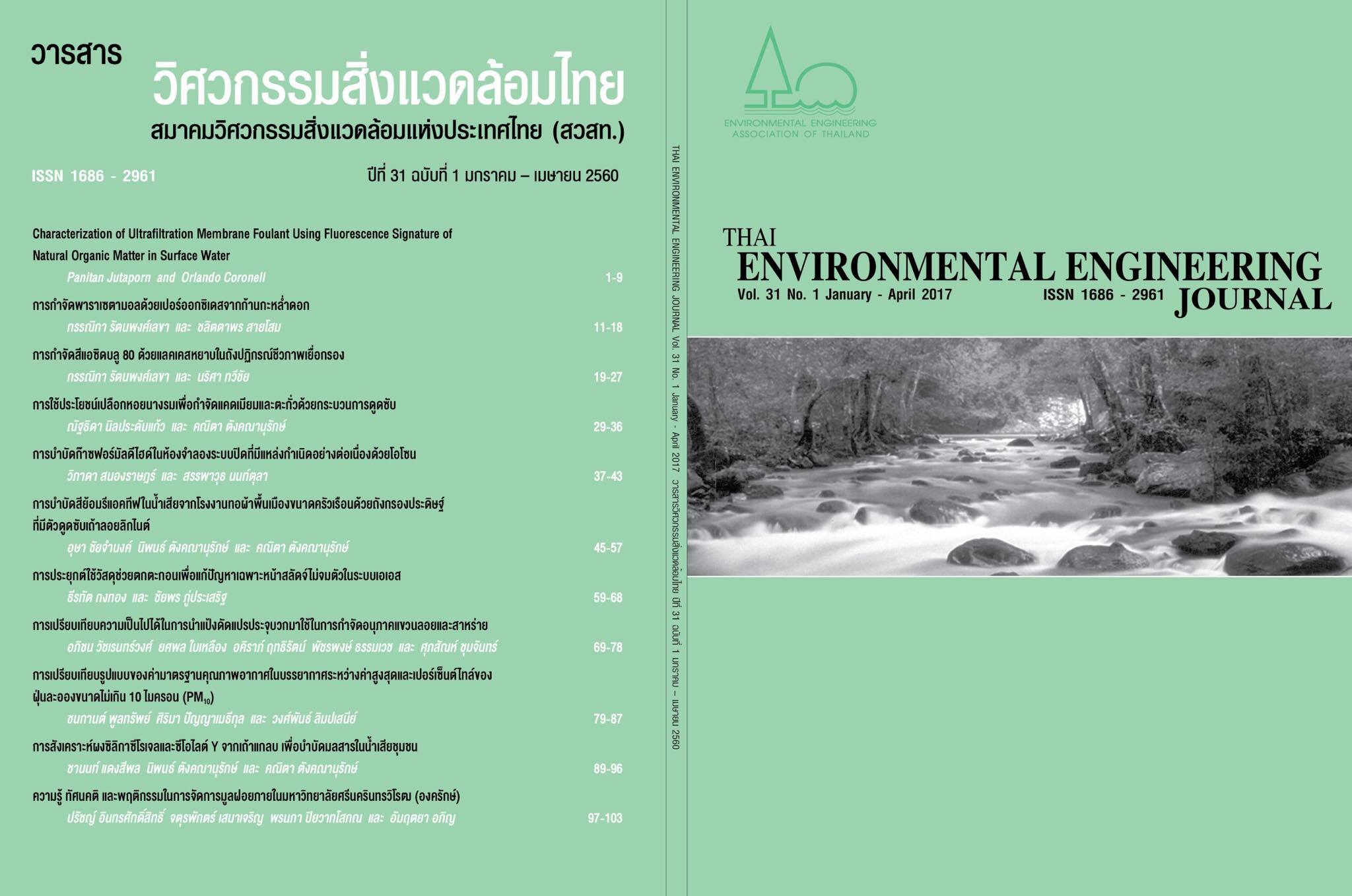Synthesis of Porous Silica Xerogel Powder and Zeolite Y from Rice Husk Ash for Pollutants Treatment in Municipal Wastewater
Main Article Content
Abstract
This research aims to utilize rice husk ash as raw material for synthesizing adsorbents with potential of pollutants treatment in municipal wastewater. The carbonised rice husk ash was carried out via alkaline extraction followed by synthesis as porous silica xerogel powder via ammonia solution addition, polymerization inhibitor of silica gel particles via proton transfer mechanism between Lewis acid and base. The results showed that carbonised rice husk ash had average yield of silica was 30.71%w/w and particle size less than 500 microns with halite and organic residue/moisture 9.51% and 0.41%, respectively, and particle density was 1.97 g/cm3. Then, zeolite Y was synthesized from this porous silica xerogel powder at a suitable batch composition Na2O : SiO2 : 0.2Al2O3 : 50H2O. From batch experiment, zeolite Y had more overall removal efficiency of pollutants in municipal wastewater than porous silica xerogel powder, especially in NH3-N. However, the adsorbate/adsorbent ratios showed that both adsorbents had more potential for pollutants treatment in municipal wastewater than lignite fly ash and bamboo charcoal.
Article Details
References
[2] Szostak, R. 1998. Molecular sieves. 2nd ed, Chapman & Hall, New York.
[3] Kalapathy, U., Proctor, A. and Shultz, J. 2000. A simple method for production of pure silica from rice hull ash. Bioresource Technol. 73: 257-262.
[4] Shelke, V. R., Bhagade, S. S. and Mandavgane, S. A. 2010. Mesoporous silica from rice husk ash. BCREC. 5(2): 63-67.
[5] Kamath, S. R. and Proctor, A. 1998. Silica gel from rice hull ash: preparation and characterization. Cereal Chem. 75(4): 484-487.
[6] Patil, R., Dongre, R. and Meshram, J. 2014. Preparation of silica powder from rice husk. ICAET-2014, 26-29.
[7] Nagrale, S. D., Hajare, H. and Modak, P. R. 2012. Utilization of rice husk ash. IJERA. 2(4): 1-5.
[8] Okutani, T. 2009. Utilization of silica in rice hulls as raw materials for silicon semiconductor. Journal of metals, materials and minerals. 19(2): 51-59.
[9] Kapur, P. C. 1985. Production of reactive bio-silica from the combustion of rice husk in a tube-in-basket (TiB) burner. Powder Technol. 44: 63-67.
[10] Ugheoke, I. B. and Mamat, O. 2012. A critical assessment and new research directions of rice husk silica processing methods and properties. Maejo Int. J. Sci. Tecnol. 6(3): 430-448.
[11] Orlovic, A. M., Janackovic, D. T. and Skala, D. U. 2005. Aerogels in catalysis, pp.39-84. In Bevy L. P., ed. New Developments in Catalysis Reseach. NOVA, New York.
[12] Plueddemann, E. P. 1991. Silane Coupling Agent. Plenum Press, New York.
[13] Kepert, C. J. 2011. Metal – organic framework material, pp. 1 – 69. In Bruce, D. W., Hare, D. O. and Walton, R. I., eds. Porous Materials. A John Wiley and Son, Ltd, United Kingdom.
[14] Kalapathy, U., Proctor, A. and Shultz, J. 2002. An improved method for production of silica from rice hull ash. Bioresource Technol. 85: 285-289.
[15] Wang, H. and Shadman, F. 2013. Effect of particle size on the adsorption and desorption properties of oxide nanoparticle. AlChE Journal. 59(5): 1502-1510.
[16] Rahman, M. N., Awang, M. B. and Yusof, A. M. 2012. Preparation, characterization and application of zeolite – Y (NaY) for water filtration. Australian Journal of Basic and Applied Science. 6(1): 50-54.
[17] Kawkeaw, K. 2015. Constructed Filter Tank with Bamboo Charcoal Adsorbent for Domestic Wastewater Treatment. M.S.Thesis, Kasetsart University. (in Thai)
[18] Kongkul, K. 2016. Coagulation Capability of Lignite Fly Ash on Municipal Wastewater Treatment Comparing with Alum. M.S.Thesis, Kasetsart University. (in Thai)


